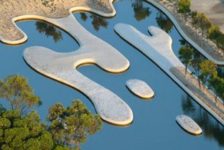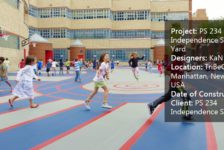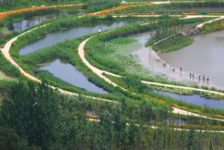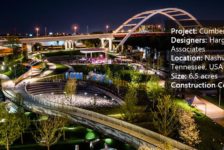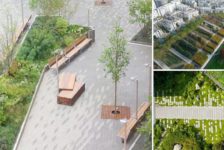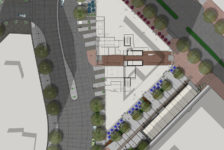I was walking through a new square in Tel Aviv the day when I saw 10 baby strollers parked in a row with no one around. As I went closer I discovered a sunken garden, with lots of babies and small children playing in the winter sun while parents lounged on the large steps that led to the sunken area. The sunken garden was designed by the famous Israeli sculptor Dani Karavan, who is more known for his memorial monuments in Israel and around the world. Dani Karavan designed the Kikar Levana an environmental sculpture that sits atop a small hill, at the Edith Wolfson Park, in Tel Aviv. The sculpture’s name means White Square. It is located at the highest point in Tel Aviv where the city meets nearby Givatayim. Interestingly enough the monument acts as a really active space for kids who want to have fun and play, creating all sorts of interesting spaces with the unique architecture and design of the space. Habima Square on a week day Habima Square on the weekend – packed with people! As it turns out, this sunken garden is an ideal children’s playground. It is covered in soft grass, it has fun pathways made of wood, it has interesting plants, and most importantly, it is a safe place. Kids cannot easily run up the large stairs and out into the open where they could reach the busy roads. It has turned into the perfect spot for parents to bring their kids to catch some lovely winter sun. Was this garden designed for children, or was it a happy accident? High-density cities like Tel Aviv offer few places where kids can run free. There are small fenced playgrounds in the middle of boulevards, and small city parks. With over half the world’s population now living in cities, outdoor spaces for children to play are important to vast numbers of people. There is a trend towards children playing outside less and less as parents fear for their children’s safety. A 2009 report by Natural England found that only 10% of children played in woodland, compared with 40% of their parents’ generation. Another recent report found that 25% of British children never play outside, in a survey of 1000 people around the country Outdoor spaces designed with children in mind are vital for good health. The growing obesity epidemic in developed countries has been linked to poor diets and physical inactivity (Check out this report). There is a positive correlation between playing outside and high levels of physical activity, suggesting that outdoor play areas are key for healthy children. Children that spend longer time outside achieve longer spans of concentration, are less sick, have better gross motor development, and their play activities are more diverse. Access to quality urban outdoor environments is also very important for children’s development, with the quality of outdoor spaces for children influencing children’s physical, emotional and social development. In his ground-breaking book, Last Child in the Woods: Saving Our Children from Nature Deficit Disorder (2005), Richard Louv makes a case for the value of spontaneous outdoor play and creating a connection with nature during childhood. He cites many positive benefits of frequent outdoor experiences as a part of children’s everyday lives. Positive outdoor experiences can foster happier, healthier, smarter, and more well-adjusted children and can create future stewards of the earth. Landscape architecture for children has been developing over the past 80 years. In the mid-1900s, Lady Allen of Hurtwood, a landscape architect and child advocate remarked “Better a broken arm than a bruised spirit”. She also once urged New York parents to sue the city fathers “for emotional damage to their children because they failed to provide suitable and exciting playgrounds for them.” Landscape architects are designing spaces specifically for children, spaces that allow children to play, use their imagination, and interact with others and the environment. Good landscape design for children ensures the space is fun, safe and educational. There are some amazing play spaces being designed around the world, and here are just a few. The sculptural playground in Schulberg, Germany, is an artistically designed children’s play area with a ‘sculpture in space”.
This park has become and place for all children in the neighbourhood to play and interact Maine botanical garden’s Children’s Garden is a ‘no-tech, elegant space with opportunities for both activity and quiet play.
The playground in Belleville Park, Paris, is located on a high-pitched slope; the playground area is a climbing course with different inclinations for different levels and different age groups. The design of the Woodland Discovery Playground at Shelby Farms Park in the US encourages play and discovery, embracing fun and delight while cultivating healthy development of children’s physical and social well-being. The playground provides an environment that promotes interaction and engagement — children must enter, move around and look for opportunities to slide, climb, run, scramble, swing, build, find and discover. Involving kids in the landscape design process. A number of design projects around the world have involved children directly to help create spaces that they enjoy. The Landscape Institute in the UK provides a guide for engaging school students in the design process , and provides a number of examples of engaging with children. Garden city play park, Richmond, BC, Canada. The architects of this play park conducted workshops and design exercises with the local community, child care professionals and decision makers. This gave the designers a unique ability to create and inspire change in outdoor play spaces, resulting in site-specific designs that foster healthy development of children and strong connections to the natural world. The environment is our life support system, and any opportunity for children to interact with the great outdoors helps them learn and understand more about the world around them. As they grow they can understand how dependent people are on nature, and how we need to nurture the earth, just like they are being nurtured themselves. Landscape architects have an important role to play in creating safe, fun and accessible outdoor spaces for children to play, exercise, interact and learn. Article by guest writer Jo Savil
This article was originally submitted to Landscape Architects Network
Published in Blog



